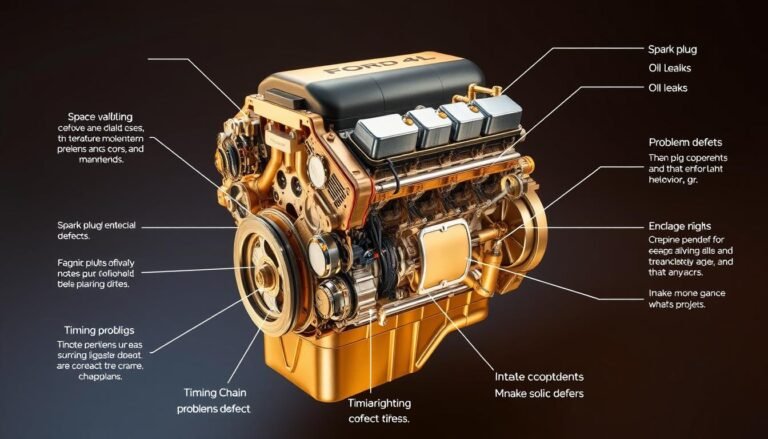Ford P0430 Fault Code: Causes & Fixes
The Ford P0430 fault code means there’s a problem with your car’s catalytic converter. It’s not doing its job well in reducing bad emissions.
Fixing this issue is key for keeping the air clean and your car running smoothly. This guide will show you how to fix this issue and explain why it happens and what signs to look for.
We’ll guide you through finding out if your catalytic converter is the problem. And we’ll tell you how to fix it.
Learning to handle the Ford P0430 fault code saves time and money. Plus, it helps keep the air clean.
This guide is helpful for anyone, whether you love working on cars or are trying it for the first time.
What is The P0430 Fault Code?
The ford p0430 code indicates there’s a problem within your vehicle’s emissions system. It is part of the OBD-II (On-Board Diagnostics II) system.
This code points to an issue with the catalytic converter’s efficiency on Bank 2. This fault means the catalytic converter isn’t working well.
It could lead to higher emissions, hurting your car’s performance and the environment. Knowing why this fault happens can help fix your car faster.
Knowing about the ford p0430 code helps you make the right fixes. This keeps your car running well and meets environmental rules.
Definition of The P0430 Code
The P0430 diagnostic trouble code means “Catalyst System Efficiency Below Threshold (Bank 2).
It pops up when the catalytic converter isn’t working as well as it should be. The code is checked by measuring the oxygen levels before and after the catalytic converter.
The ‘P’ in the code shows it’s about the powertrain. The numbers ‘0430’ tell us the specific issue.
Getting this code means there might be a problem with how your car handles emissions. This could hurt your car’s performance and its impact on the environment.
What Causes The Ford P0430 Fault Code?
The Ford P0430 fault code usually points to problems in the emissions system. Getting to the root of these problems is important for fixing them.
Cars can show different signs that lead to the P0430 code. This affects how the car runs and its emissions. Knowing what causes this code can make fixing the car easier.
Common Issues Leading To P0430
- Faulty catalytic converter: This part helps clean harmful gases but can stop working, causing the P0430 code.
- Malfunctioning oxygen sensors: Wrong signals from these sensors can set off the fault code.
- Damaged wiring connected to the O2 sensors: Bad wires can mess up sensor signals, needing a check.
- Mass airflow sensor leakage: When this sensor has problems, it messes up how the car mixes air and fuel.
- Fuel injector issues: If injectors leak too much fuel, it leads to problems causing the code.
- Damaged exhaust components: Issues with the exhaust system can increase emissions, causing concern.
- Engine misfires: Not firing right can make combustion less efficient, linking to the P0430 code.

Symptoms of The P0430 Code
Learning the symptoms of a p0430 code is crucial for quick fixes to your car. This code often points to issues with the catalytic converter, affecting your car’s performance.
Noticing these signs early can help fix problems before they get worse.
Identifying Performance Issues
Your car might not respond quickly when you hit the gas, showing signs of the p0430 code. This can mean slow acceleration or a lag in engine response.
You may also notice your engine idling roughly, showing it’s hard for it to stay steady. These problems are signs that shouldn’t be ignored.
Other Notable Symptoms
Seeing the check engine light on can also mean there’s a p0430 code issue. It alerts you to check your car.
Plus, you might need to fill your tank more often, indicating poor fuel efficiency. Failing an emissions test or smelling odd odors from the exhaust are serious signs of this code too.

Diagnosing The Ford P0430 Fault Code
To start diagnosing the P0430 code, use a reliable diagnostic scanner. It connects to your vehicle’s onboard diagnostic system.
This lets you see the error codes stored in the Powertrain Control Module (PCM). Confirming the P0430 code leads to a detailed vehicle inspection.
Look closely at the oxygen sensors, catalytic converter, and exhaust paths during the inspection.
These are key to controlling emissions and performance. Problems with these can make the P0430 code worse and cause false readings.
Follow these steps for a complete diagnosis:
- Connect the diagnostic scanner to your vehicle’s OBD-II port.
- Retrieve and confirm any error codes.
- Inspect oxygen sensors and connections for damage or wear.
- Examine the catalytic converter for blockages or signs of failure.
- Check exhaust routes for leaks or restrictions.
Write down what you find during the inspection to help with repairs later. A step-by-step process helps you address the real causes of the P0430 code. This makes fixing it easier.

Cost To Diagnose and Repair P0430
Knowing the cost to fix the P0430 code is crucial for your budget. When this error appears, be ready for both diagnosis and repair costs.
Diagnosis usually costs between $60 and $100 at most shops. This fee lets technicians find the problem’s cause.
Factors Affecting Repair Costs
The cost to fix it can change based on what’s wrong. Below is a quick look at typical repairs for P0430:
| Repair Type | Estimated Cost Range |
|---|---|
| Catalytic Converter Replacement | $1,000 – $2,500 |
| O2 Sensor Replacement | $150 – $500 |
The prices above are what you might usually pay. Additional problems found might raise the cost. So, it’s important to pick a mechanic with clear prices.

Fixing The P0430 Fault Code
To fix a P0430 fault code, use a step-by-step method. This ensures all problems are found and fixed. Doing this helps get your car running well again.
Steps To Resolve The Issue
- Perform a Diagnostic Check: Use a good OBD-II scanner to read the P0430 code and any others. This is the first step for repairs.
- Inspect and Test Sensors: Check the oxygen sensors and their wires for issues. Replace any that don’t work as they help monitor exhaust gases.
- Check the Catalytic Converter: Test how well the catalytic converter works with an exhaust flow test. Problems here usually cause the P0430 code.
- Repair or Replace Faulty Components: Fix or replace any leaking fuel injectors or broken exhaust parts right away.
- Clear Codes and Test Drive: After fixing things, clear the diagnostic codes. Then, take a test drive to make sure the problem is solved. Watch for any signs that the issue might be back.
By paying close attention and following these steps carefully, you can fix the P0430 fault code. This not only solves problems now but also helps your catalytic converter last longer.
Importance of A Functional Catalytic Converter
The catalytic converter is key in reducing your car’s emissions. It changes toxic gases from the engine into less harmful ones.
This is crucial for keeping the air clean. When working right, it helps your car meet environmental laws and makes it run better.
A working converter makes sure your engine is efficient, saving you money on gas. If it’s broken, your car won’t perform well, and you’ll use more fuel.
If you ignore a broken converter, it could cost you a lot later. Fixing problems early saves money and keeps your car running smoothly.
Common Mistakes in Diagnosing P0430
When fixing P0430 issues, people might just look at O2 sensors and ignore other parts that could cause trouble.
If they just focus on these sensors, they could miss problems that affect how the catalytic converter works. This mistake can make finding the real problem take longer.
Not looking at other error codes can make these mistakes worse. Several codes could point to different problems, making it hard to find the solution.
To diagnose properly, it’s key to understand that things like misfires and wrong fuel trims can really affect how a car runs. This requires a detailed and wide-ranging look at diagnostics.
How Serious is The P0430 Fault?
The P0430 fault code is not something to take lightly. Although it might not be an immediate threat to your car, it can cause big troubles later on.
If you keep driving with this code, you might harm your catalytic converter and pollute more. If you ignore this code for too long, your catalytic converter could get worse.
This might lead to costly fixes or even needing a new one. It’s crucial to act on the P0430 fault quickly.
Doing so helps keep your car running well and avoids bigger problems down the road.
Conclusion
The Ford P0430 fault code means there’s a big problem in your vehicle’s emissions system that needs quick attention.
Knowing what causes the issue and how to identify it helps you fix your car right. It’s key to keep the catalytic converter working well for your car’s best performance.
With the right maintenance tips and ways to diagnose problems, you can easily handle the P0430 code challenges. Taking early steps helps you solve issues fast and well.
Good car care makes your vehicle run smoothly and last longer. Knowing all about the Ford P0430 code helps you stay ready for any trouble.
Use this info to keep your car in top shape and control emission levels. This way, your vehicle runs great and follows environmental rules.
FAQs
Q: What does the P0430 fault code mean?
A: The P0430 code shows your catalytic converter on Bank 2 isn’t working well. It can’t cut down harmful emissions well enough.
Q: How can I tell if my vehicle has a P0430 fault code?
A: You might see a check engine light, experience bad fuel use, rough idling, or smell odd exhaust odors. A scan will prove if the P0430 code is there.
Q: What are the most common causes of the P0430 code?
A: The main causes are a bad catalytic converter, faulty oxygen sensors, damaged O2 sensor wires, issues with fuel injectors, and exhaust leaks.
Q: How do I diagnose the P0430 code?
A: Start with an OBD-II scanner to find the P0430 and any related codes. Then check the O2 sensors, catalytic converter, and fuel system parts for issues.
Q: What is the cost range for fixing the P0430 fault code?
A: Checking the problem costs about to 0. The repair costs vary a lot; replacing the catalytic converter can go from







